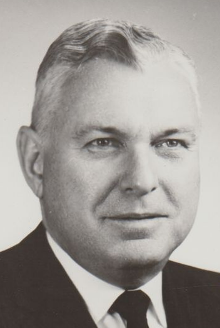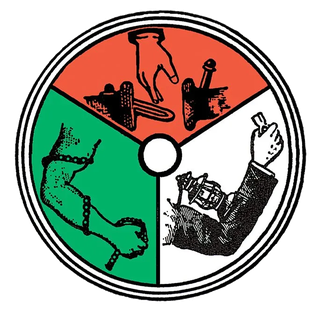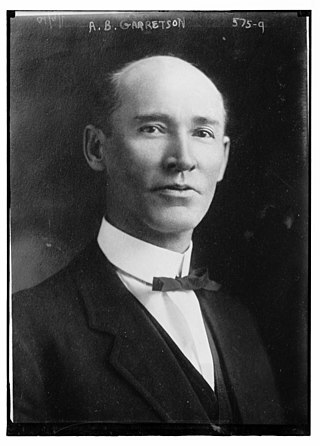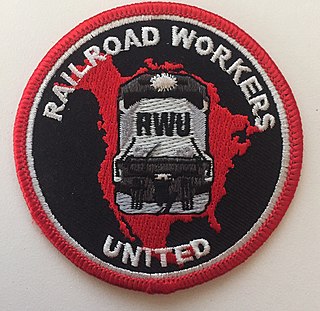The United Transportation Union (UTU) was a broad-based, transportation labor union that represented about 70,000 active and retired railroad, bus, mass transit, and airline workers in the United States. The UTU was headquartered in Cleveland, Ohio. On August 11, 2014, it merged with the Sheet Metal Workers' International Association (SMWIA) to form the International Association of Sheet Metal, Air, Rail and Transportation Workers, known by the acronym SMART.

The Transportation Communications Union (TCU) is the successor to the union formerly known as the Brotherhood of Railway Clerks and includes within it many other organizations, including the Brotherhood of Railway Carmen of America and the Brotherhood of Sleeping Car Porters, that have merged with it since 1969.

The Adamson Act was a United States federal law passed in 1916 that established an eight-hour workday, with additional pay for overtime work, for interstate railroad workers.

The Brotherhood of Locomotive Engineers and Trainmen (BLET) is a labor union founded in Marshall, Michigan, on 8 May 1863 as the Brotherhood of the Footboard. It was the first permanent trade organization for railroad workers in the US. A year later it was renamed the Brotherhood of Locomotive Engineers. The B of LE took its present name in 2004 when it became a division of the Rail Conference of the International Brotherhood of Teamsters (IBT).
The Sheet Metal Workers' International Association was a trade union of skilled metal workers who perform architectural sheet metal work, fabricate and install heating and air conditioning work, shipbuilding, appliance construction, heater and boiler construction, precision and specialty parts manufacture, and a variety of other jobs involving sheet metal. On August 11, 2014, it merged with the United Transportation Union (UTU) to form the International Association of Sheet Metal, Air, Rail and Transportation Workers, known by the acronym, SMART.
The railroad brotherhoods are labor unions of railroad workers in the United States. They first appeared in 1863 and they are still active. Until recent years they were largely independent of each other and of the American Federation of Labor.
Railway Labor Executives' Association (RLEA) was a federation of rail transport labor unions in the United States and Canada. It was founded in 1926 with the purpose of acting as a legislative lobbying and policy advisory body. At times, it played a prominent role in setting rail transport policy in the U.S., and was party to six U.S. Supreme Court cases. It disbanded in January 1997, with representation, collective bargaining, and legislative lobbying assumed by the newly formed Rail Division of the AFL–CIO Transportation Trades Department.

The Brotherhood of Railroad Trainmen (BRT) was a labor organization for railroad employees founded in 1883. Originally called the Brotherhood of Railroad Brakemen, its purpose was to negotiate contracts with railroad management and to provide insurance for members.

The Switchmen's Union of North America (SUNA) was a labor union formed in October 1894 that represented the track switch operators and people who coupled railway cars in railway yards in the United States and Canada. It became part of the United Transportation Union in 1969.

William Parker Kennedy was president of the Brotherhood of Railroad Trainmen (BRT) from 1949 to 1962.

Charles Luna was president of the Brotherhood of Railroad Trainmen (BRT) from 1963 until 1969. He became the first president of the United Transportation Union, when that organization was formed by merging the BRT and three other railroad unions in 1969.

The Order of Railway Conductors of America (ORC) was a labor union that represented train conductors in the United States. It has its origins in the Conductors Union founded in 1868. Later it extended membership to brakemen. In 1969 the ORC merged with three other unions to form the United Transportation Union.
The Order of Sleeping Car Conductors (OSCC) was a labor union that represented white sleeping car conductors in the United States and Canada between 1918 and 1942, when it merged with the Order of Railway Conductors.
Harry W. Fraser was an American labor leader who was president of the Order of Railway Conductors (ORC) from 1941 to 1950.

Austin Bruce Garretson was an American labor leader who was head of the Order of Railway Conductors from 1906 to 1919. He gained national prominence in 1916 when he averted a nationwide railroad strike in exchange for an eight-hour day with time-and-a-half overtime pay.
The International Association of Railway Employees (IARE) was a union for black railroad workers formed in 1934 at a time when the major railroad brotherhoods restricted membership to whites. Members included conductors, trainmen, engineers, shop mechanics, porters and maintenance-of-way employees. It joined the United Transportation Union in 1970.

John Frederick Sytsma was President of the Brotherhood of Locomotive Engineers (BLE) from 1976 to 1986.
The International Association of Sheet Metal, Air, Rail, and Transportation Workers (SMART) is a North American labor union headquartered in Washington, D. C., was chartered by the AFL–CIO in 2013. The product of a merger between the Sheet Metal Workers’ International Association (SMWIA) and the United Transportation Union (UTU), SMART represents over 210,000 sheet metal workers, service technicians, bus operators, engineers, conductors, sign workers, welders, and production employees, among others, throughout the United States, Puerto Rico, and Canada. The Transportation Division represents employees on Class I railroad, Amtrak, and regional and short line railroads; bus and mass transit employees on some 45 transit systems; and airline pilots, flight attendants, dispatchers and other airport personnel. The Division's 500 local unions organize conductors, brakemen, switch men, ground service personnel, locomotive engineers, hostlers, and railroad yard masters, as well as bus drivers and mechanics.

Railroad Workers United (RWU) formerly known as Railroad Operating Crafts United is a cross-union rail workers’ reform group that was started as a result of a push by workers from the United Transportation Union and the Brotherhood of Locomotive Engineers and Trainmen to merge unions. They are now a cross-craft organization that supports all non-management railroad workers. RWU has a steering committee where members can be elected at their bi-annual convention.











